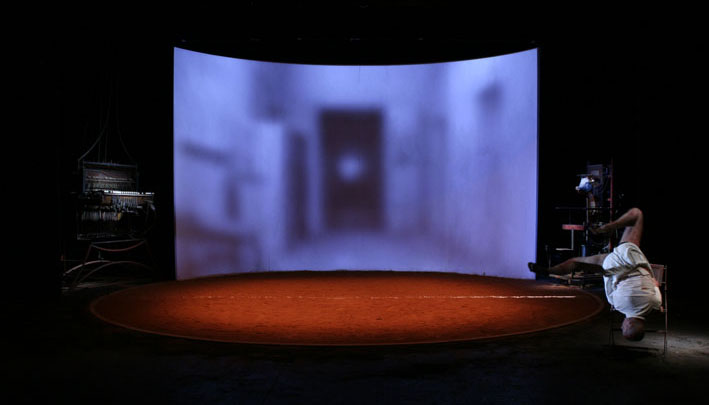
| Performing: Eleonora Sedioli, Federica Cangini | |||||
| Scenes by: Lorenzo Bazzocchi, Eleonora Sedioli | |||||
| Electronic by: Matteo Gatti | |||||
| Physical computing, lights, sound: Lorenzo Bazzocchi | |||||
| Conception and direction: Lorenzo Bazzocchi | |||||
| Production: Masque teatro, Mood indigo | |||||
Loosely based on Francis Bacon: The Logic of Sensation by Gilles Deleuze.
This essay by the French philosopher is to be considered an out-and-out compendium for performing arts.
Deleuze identifies three elements in Bacon’s painting:
-large backgrounds, as spatialization material structure
-the Figure, the Figures and their action
-the contour
The contour is considered as the place of an exchange in both directions. The Figure is sometimes seated on a chair, some others it’s lying on a bed. It seems as if it’s waiting for something to happen.
In identifying the movement dynamics and thus a perception rhythmics, we accept Deleuze’s hypothesis: what happens is about to happen or it’s already happened.
While working on the figure we utilized the so called coefficient of bodies deformation and especially, as Bacon himself suggests, the extension one. We followed what the painter thought to be necessary in order to take the Figure away from the figurative: isolating the figure. Three were the works we took into account: Head VI from 1949, Study for a bullfight N. 1 from 1969, and Painting from 1978; and three were the events we created by working on processes of isolation, strictly following Deleuze’s indications: there’s a need to construct devices that don’t force the figure to immobility, but clearly show its route through an exploration that define an operative field through that liberating operation defined by Deleuze as “sticking to the fact”.
An isolated figure is expected on the stage, who, similarly to a fighter, will have to deal with several witnesses: a demolished piano, the head of a pig-body, a bleeding suitcase. But what else is there on the stage apart from the figure? The place is supposed to be weakened in order to give place to the arena: the stage scenery conceived by Masque is thus a spazializzante device that will approach the figure by physically interacting with it, and that will then move away as a perspective tool; it will expand in order to allow anamorphosis, and it will compress to pressurize. A few minutes after the beginning of the performance you can feel a tactile sensation in the air: the structure becomes the device trough which the spectator touches the figure with his hand. Two are the questions regarding the hand: what it says and how it works. If the only organic sign is a bodyless-head-body, it’s still true that this tension between the structure and the figure, between the figure and the witness, is working. It’s hard not to recur to Self-portrait of 1973, to that man with the pig’s head in which the deformation takes place on stage. The effort of the body acts on itself. Deleuze hints at this idea, floating on the circle of a contour that establishes the rules of sense survival and reminds us of how our whole body is penetrated with movement = “deformedly deformed movement, constantly bringing the real image back to the body to build the figure…A painting can help us in understanding. Figure standing at a washbasin of 1976: clung to the oval of the washbasin, with its hands sticking to the taps, the body-figure forces itself to an intense motionless movement in order to be able to escape, passing through the waste pipe”